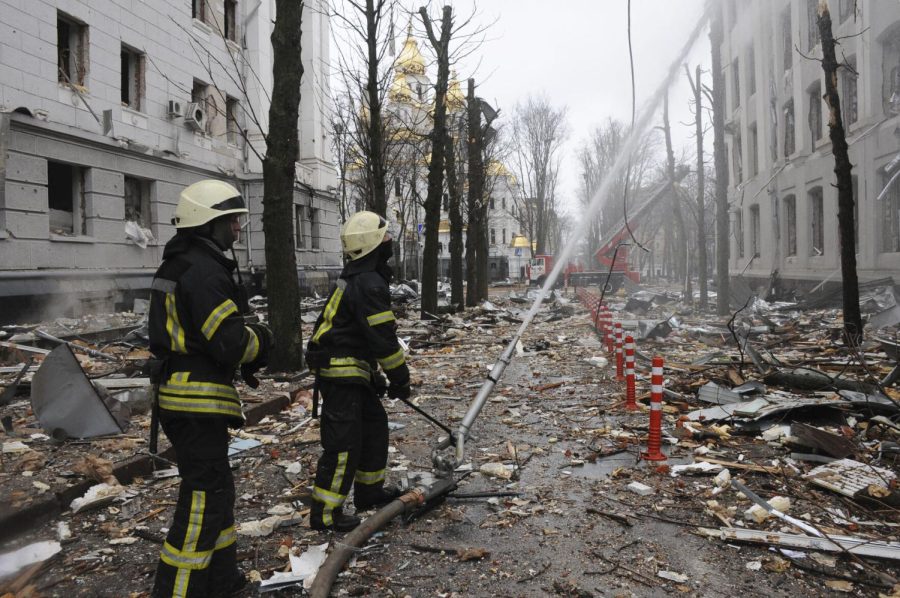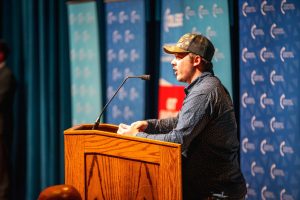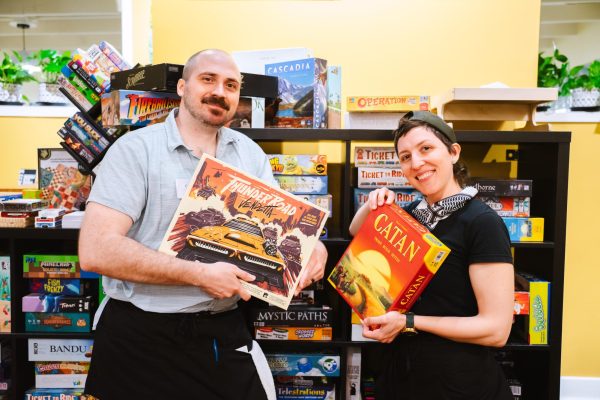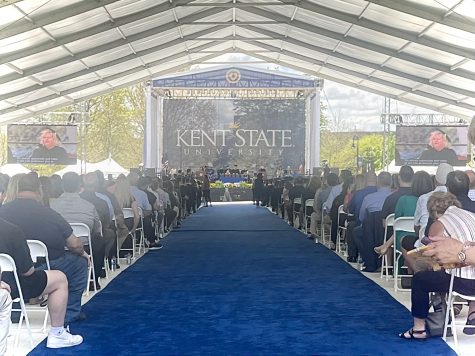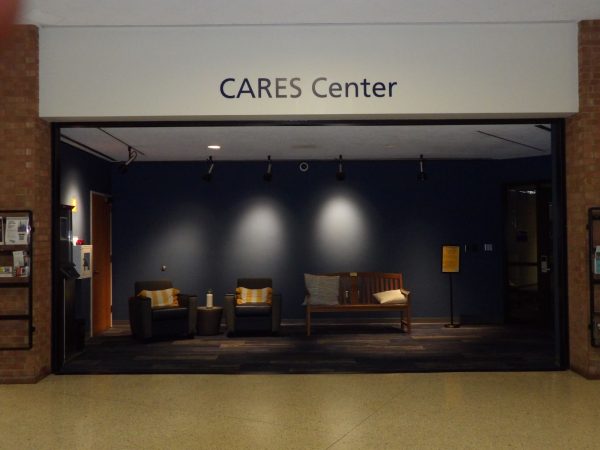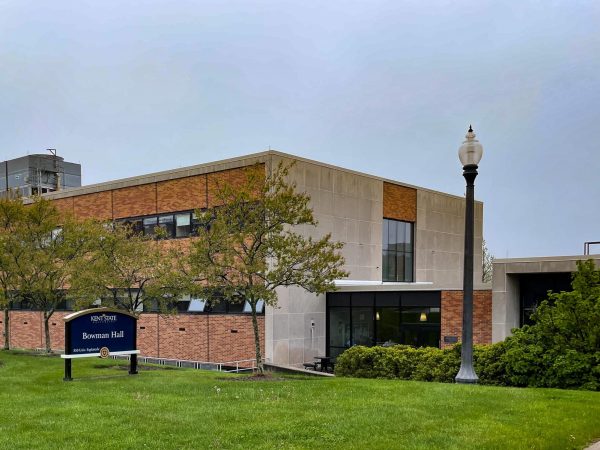History behind Russia’s invasion of Ukraine, explained by Kent State experts
Firefighters extinguish a building of Ukrainian Security Service (SBU) after a rocket attack in Kharkiv, Ukraine’s second-largest city, Ukraine, Wednesday, March 2, 2022. Russia’s assault on Kharkiv, Ukraine’s second largest city, continued Wednesday, with a Russian strike hitting the regional police and intelligence headquarters, according to the Ukrainian state emergency service. (AP Photo/Andrew Marienko)
March 2, 2022
Editor’s Note: The following story was updated to specify the roles of the European Union and the North Atlantic Treaty Organization as it relates to the Russian invasion of Ukraine.
In the early hours of Thursday, Feb. 24, Russia invaded neighboring Ukraine, with missile fire kicking off what Russian President Vladimir Putin called a “special military operation.”
Since Russia’s initial invasion of Ukraine, no large cities have fallen, though fighting is intense in the cities of Kharkiv and Kyiv, which lie near the Russian border. Aid from the EU and the U.S. have been exclusively in the form of supplies sent to the front line, alongside economic sanctions against Russia, because Putin has given harsh warnings against military intervention.
Initially several European nations rejected the notion of cutting off Russia from SWIFT, an electronic bank transfer system that allows transactions to be easily and quickly made between national borders. Plans for how to properly cut Russia off from the system are now being discussed. Cutting Russia off from SWIFT would cripple its ability to use much of its financial stockpile to purchase military supplies, said Andrew Barnes, coordinator of Kent’s international relations program.
German Chancellor Olaf Scholz’s suspension of the Nord Stream 2 natural gas pipeline, which runs from Russia to Germany, may make a major difference, Barnes said. However, Putin was likely aware of potential sanctions prior to the invasion, he said.
Within Russian borders, protests have erupted, centered in Saint Petersburg and Moscow. Over a thousand protestors were arrested in Moscow Feb. 28.
Citizens’ militias have been armed by the government and have taken to the streets in cities throughout Ukraine. Both Kyiv’s mayor and former President Petro Poroshenko have joined the capital city’s militia, while current President Volodymyr Zelensky has become the face of Ukrainian resistance for his speeches and diplomatic appeals.
Civilian casualties are above 500, but Ukraine shows no signs of surrendering. A clip of Ukrainian soldiers defiantly swearing at a Russian warship while defending an island in the Black Sea went viral, with Zelensky awarding all the defenders the title of Hero of Ukraine. Russian missiles have targeted residential districts in Kharkiv, and each day brings more death.
Evacuation has been underway since the initial invasion, with hundreds of thousands of refugees streaming out of Ukraine into neighboring nations like Poland and Slovakia. The American 82nd Airborne is in Poland, helping to accommodate Americans fleeing the war. While the Polish and Slovak governments have been very welcoming to refugees so far, Barnes warned that, as the war drags on, this initial sense of welcome may become tense over time.
Why did Russia invade Ukraine?
The history behind Putin’s motivations for this act of war dates back decades, several Kent State professors explained.
From 1922 to 1991, Ukraine was a constituent republic of the Soviet Union. The history of Putin’s aggression towards Ukraine begins in 1991, with the collapse of the Soviet state. By the end of that year, Ukraine, along with every other Soviet republic, had voted to leave the Union and become an independent republic.
In a speech Feb. 21, Putin said allowing the non-Russian republics to leave Russian rule was a “mistake” of the Soviet government. Despite Putin’s current beliefs, Ukrainian independence wasn’t on many Russian minds in 1991, Barnes said.
“The Russian leadership was worrying about their own independence at the time and wasn’t really worrying about Ukraine,” Barnes said.
While the enforcement of borders between Russia and Ukraine may have been disruptive for those living close to the border, the overall tone was optimistic. Citizens were hopeful the new democracies would change life for the better, Barnes said.
In Ukraine, independence brought with it a desire to join the international community. While Ukraine approached the European Union during its early years as a republic, the official accession process has not started yet as the state did not meet the regional organization’s admission requirements, said Gabriella Paar-Jakli, a professor of political science at Kent State.
To join the EU, a nation needs to have a stable democracy, a market economy and a low level of political corruption, requirements that the organization thinks Ukraine did not yet meet, Paar-Jakli said.
Although Ukraine could not join either the EU or NATO in 2004, both the EU and NATO admitted former members of the Soviet Union including Latvia, Lithuania and Estonia.
“He (Putin) sees NATO as a threat. He thinks that NATO wants … Look, nobody wants to take over the territory of contemporary Russia, but he claims that (NATO does),” Paar-Jakli said.
Mary Ann Heiss, a professor of Cold War history and American foreign relations, explained that, from Putin’s perspective, NATO’s expansion could look like a threat to his power.
“He does seem to see it as a genuine security concern, that NATO is expanding closer and closer to his borders. He had a lot of military assets in Ukraine before 2014, in Crimea. ‘If Ukraine joined NATO, what would happen to those?’ he could be thinking,” Heiss said.
In late 2013, domestic tension came to a head in Ukraine after president Viktor Yanukovych made the decision not to sign a proposed agreement with the European Union. A wave of protests and violence erupted in response, and by the end of February 2014, Yanukovych had fled the capital and was relieved of his duties by the parliament.
Putin regarded this revolution as a coup, accusing the interim government of being a U.S puppet state. In response to this, Putin began to worry about his assets within Ukraine.
“Crimea is a major naval base for the Russian fleet. There was a serious tactical and strategic loss if they were going to lose their bases in Crimea,” Barnes said. “The new Ukrainian government could come in and say, ‘We no longer honor the lease, you need to move your ships.’”
Shortly after the ousting of Yanukovych, Russia invaded Crimea, annexing it within days. In Ukraine’s east, rebels declared autonomous republics in the Russian-bordered states of Donetsk and Luhansk, a region also known as Donbas. The fighting in Donbas continued until Putin launched his full invasion Feb. 24.
The provinces of Donetsk, Luhansk and Crimea are populated primarily by ethnic Russians, a fact Putin and his allies in the Russian media use as justification.
The annexation of Crimea, as well as the backing of Russian rebels in Donbas, is justified by Putin as “protecting ethnic Russians,” Barnes said.
Richard Steigmann-Gall, a history professor and fascism studies expert, described this as irredentism, a type of nationalism which portrays aggression and subjugation as necessary for “the protection of ‘the people.’”
“At this point, you just have to ask Putin, ‘Where does this end?’ All of Ukraine? Moldova? The Baltic states?’ This kind of aggressive irredentism doesn’t just end with a couple of provinces, and it’s not clear how far Putin intends to go,” Steigmann-Gall said.
Lynn Vandrasik is a reporter. Contact her at [email protected].


